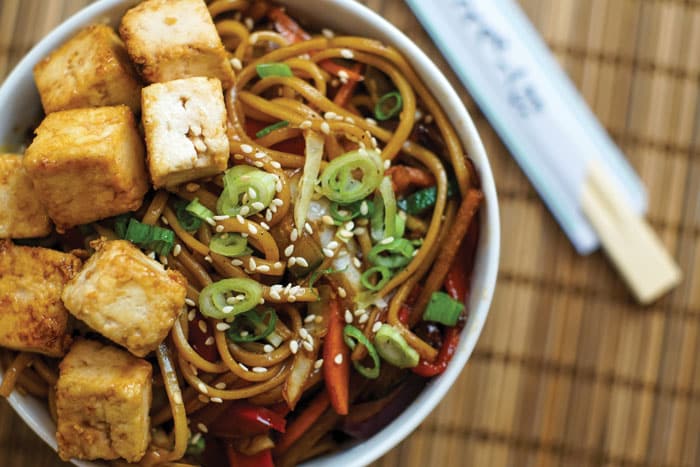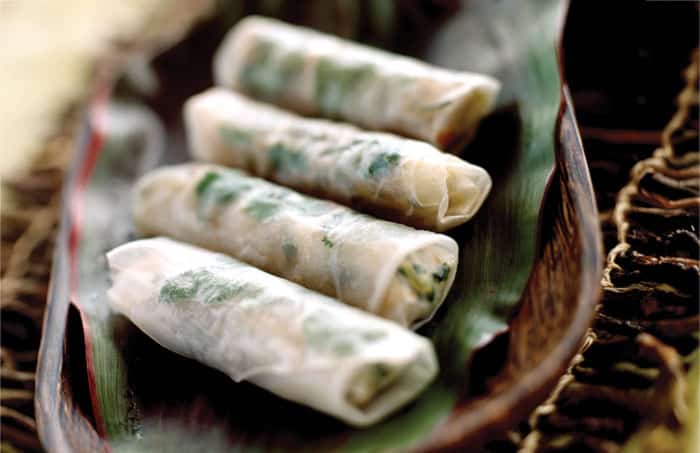 Yosyp Sani M/Getty Image
Yosyp Sani M/Getty Image The Lunar Collective is all about cultivating connection, belonging and visibility for Asian American Jews.
Lunar New Year is a multi-day celebration, observed across many Asian countries, starting this year ion Feb. 10. Each has their own cultural variations and practices. To get in the spirit of their “bonus” New Years, two LUNAR Collective members – one Chinese, one Vietnamese – share their favorite kosher Asian recipes.
“It’s a Chinese tradition to enjoy long noodles for Lunar New Year, as they symbolize longevity,” David Chiu, a Chinese-American Jew and a Los Angeles community leader of The LUNAR Collective, told the Journal.
“At the LUNAR Collective, normally Jewish holidays are what offer us the opportunities to bring people together,” he said. “It’s cool to also have an Asian holiday, which presents this opportunity, and to invite people outside LUNAR to share the table with us.”
During the Pandemic, Chiu was cooking three meals a day and started experimenting to make things more interesting. As a result, he explains, his lo mein ventured off the beaten path.
“My key ingredient is a yam to which I add purple carrots and purple cabbage for visual interest,” he said. “I love the flavor combination of noodles and yam; it’s very earthy and hearty.”
He adds, “Chinese cooking has been around for over five millennia; I’m sure I’m not the first person to add yams to my lo mein!”
David Chiu’s Lo Mein Noodles
You can buy lo mein noodles online or at an Asian grocery store like 99 Ranch Market. My dad says you can substitute spaghetti and many people do, but I like the softer texture of lo mein noodles.
I usually make this in my iron skillet over medium-high heat, although a wok over high heat is more traditional.
7 oz (half a box) of Lo Mein Noodles
Half a yam, roughly chopped into cubes
3 large leaves of purple cabbage, sliced into strips
2 purple carrots, sliced
A third of a large yellow onion, sliced
3 teaspoons of minced garlic
6 oz (usually a third of a pack) of Firm Tofu, cubed
1 Jalapeno, sliced (optional)
Dash of white pepper (if too spicy, use black pepper)
1 Tbsp of soy sauce (adjust to taste)
1 Tbsp of fish sauce (adjust to taste)
1 Tbsp of hoisin sauce (adjust to taste)
Peanut oil
1 Tbsp of toasted sesame oil (adjust to taste)
Boil and drain the Lo Mein Noodles separately according to the instructions on the box. Set aside (or cook simultaneously with what you’re making in your skillet).
Heat a skillet (or wok) on medium-high heat until it is hot, then pour enough peanut oil to coat the bottom of the pan. Toss in the chopped yam and sliced carrots and stir fry until soft but not yet browning.
Add the sliced purple cabbage, sliced yellow onion, minced garlic and jalapeno. Stir fry for a couple minutes until the cabbage is softened and the onion, garlic, yams, and carrots are just starting to brown.
Add the cubes of firm tofu and keep stir-frying for another 2-3 minutes or until tofu is cooked. Reduce heat to low.
Add another tablespoon of peanut oil and stir around enough cover to coat the ingredients and recoat the bottom of the pan, then add the cooked lo mein noodles. Add the soy sauce, fish sauce, hoisin sauce, and white pepper. Stir fry the noodles until they’re mixed with the ingredients and some of the noodles are becoming just ever so slightly crispy.
Remove from heat. Add toasted sesame oil and toss until the noodles and other ingredients are lightly coated with it.
Plate and serve. Serves 2.

Leila Chomski is a 22-year-old modern-orthodox half-Vietnamese Jewish Asian woman.
“When I was an Orthodox Jewish Asian kid eating kosher Asian food at local restaurants, I couldn’t help but feel that the food didn’t taste that great or wasn’t authentic,” Chomski told the Journal. “From one restaurant to another the food looked very similar and tasted oily and processed.”
Chomski thinks she would have grown up thinking all Asian food tasted bad if it wasn’t for her mom’s spring rolls.
“They put all the local Chinese restaurants to shame with their savory fresh chicken flavor, crunchy texture and hearty, tasty filling,” she said. “My orthodox friends would come over and practically beg for a taste; my mom happily obliged.”
Chomski calls her recipe a symbol of expressing Judaism in the way in which you are comfortable. It’s kosher and Asian, and “a way of celebrating myself,” she said. “Like the spring rolls, the more I explore my Asian heritage, the more I feel able to balance my two identities without sacrificing either one.”
Leila Chomski’s Kosher Vietnamese Spring Rolls
You should be able to find all ingredients at a kosher supermarket, thus making the recipe kosher certified.
1 lb ground chicken
2 Tbsp soy sauce
2 Tbsp sugar
1 tsp salt
½ cup shredded carrots
1 package rice paper
Mix together ground chicken, soy sauce, sugar, salt and vegetables.
Wet rice paper by laying it between damp towels. This allows you to wet multiple sheets at the same time.
Extract a sheet of rice paper, add a handful of the ground chicken mixture – you may want to wear gloves – and roll it in the rice paper, folding on either side. Fry it for five minutes on each side.
Serve with soy sauce.























 More news and opinions than at a Shabbat dinner, right in your inbox.
More news and opinions than at a Shabbat dinner, right in your inbox.